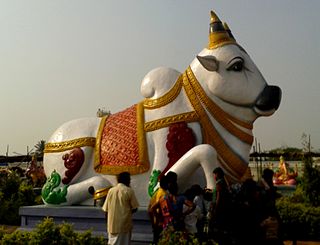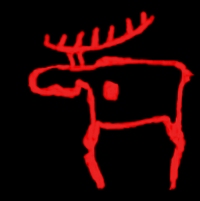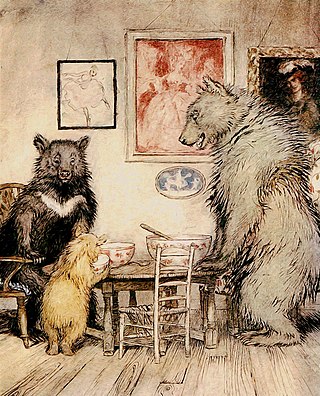
A national myth is an inspiring narrative or anecdote about a nation's past. Such myths often serve as important national symbols and affirm a set of national values. A national myth may take the form of a national epic, or it may be incorporated into a civil religion. A group of related myths about a nation may be referred to as the national mythos, from μῦθος, Greek for "myth".

The Indigenous peoples of the Americas comprise numerous different cultures. Each has its own mythologies, many of which share certain themes across cultural boundaries. In North American mythologies, common themes include a close relation to nature and animals as well as belief in a Great Spirit that is conceived of in various ways.
Finnish mythology commonly refers of the folklore of Finnish paganism, of which a modern revival is practiced by a small percentage of the Finnish people. It has many shared features with Estonian and other Finnic mythologies, but also with neighbouring Baltic, Slavic and, to a lesser extent, Norse mythologies.
Hiisi is a term in Finnic mythologies, originally denoting sacred localities and later on various types of mythological entities.
Peijaiset is a Finnish concept, dating to pre-Christian times, denoting a memorial feast that was held to honour a slain animal, particularly the bear, the animal most sacred to ancient Finns. In modern-day usage, it often refers to the celebrations following a successful elk hunt, or a feast at the end of a hunting season. It may also be used in a figurative sense, denoting any memorial held for things that have come to an end. Traditionally, it referred to wakes for humans and animals, but also other celebrations, depending on the region in question.
In Finnish mythology, Tuoni was the god of Tuonela, and darkness personified. He was the husband of Tuonetar. Their children included Kipu-Tyttö, Tuonenpoika, and Loviatar, who were divinities of suffering. When in human form, he appears as an old man with three fingers on each hand and a hat of darkness.

Animal worship is an umbrella term designating religious or ritual practices involving animals. This includes the worship of animal deities or animal sacrifice. An animal 'cult' is formed when a species is taken to represent a religious figure. Animal cults can be classified according to their formal features or by their symbolic content.

Finnic paganism was the indigenous pagan religion in Finland, Karelia, Ingria and Estonia prior to Christianisation, the religion was native to the Baltic Finnic peoples. It was a polytheistic religion, worshipping a number of different deities. The principal god was the god of thunder and the sky, Ukko; other important gods included Jumo (Jumala), Ahti, and Tapio. Jumala was a sky god; today, the word "Jumala" refers to all gods in general. Ahti was a god of the sea, waters and fish. Tapio was the god of forests and hunting.
Estonian mythology is a complex of myths belonging to the Estonian folk heritage and literary mythology. Information about the pre-Christian and medieval Estonian mythology is scattered in historical chronicles, travellers' accounts and in ecclesiastical registers. Systematic recordings of Estonian folklore started in the 19th century. Pre-Christian Estonian deities may have included a god known as Jumal or Taevataat in Estonian, corresponding to Jumala in Finnish, and Jumo in Mari.

Modern Finnish paganism, also known as Finnish neopaganism or the Finnish native faith, is the contemporary revival of Finnish paganism, the pre-Christian polytheistic ethnic religion of the Finns. A precursor movement was the Ukonusko of the early 20th century. The main problem in the revival of Finnish paganism is the nature of pre-Christian Finnish culture, which relied on oral tradition which may be subject to change over time. The primary sources concerning Finnish native culture are written by latter-era Christians.
Loviatar is a blind daughter of Tuoni, the god of death in Finnish mythology and his spouse Tuonetar, the queen of the underworld. Loviatar is regarded as a goddess of death and disease. In Runo 45 of the Kalevala, Loviatar is impregnated by a great wind and gives birth to nine sons, the Nine diseases. In other folk songs, she gives birth to a tenth child, who is a girl.

Bear worship is the religious practice of the worshipping of bears found in many North Eurasian ethnic religions such as among the Sami, Nivkh, Ainu, Basques, Germanic peoples, Slavs and Finns. There are also a number of deities from Celtic Gaul and Britain associated with the bear, and the Dacians, Thracians, and Getians were noted to worship bears and annually celebrate the bear dance festival. The bear is featured on many totems throughout northern cultures that carve them.

Tibetan mythology refers to the traditional as well as the religious stories that have been passed down by the Tibetan people. Tibetan mythology consists mainly of national mythology stemming from the Tibetan culture as well as religious mythology from both Tibetan Buddhism and Bön Religion. These myths are often passed down orally, through rituals or through traditional art like sculptures or cave paintings. They also feature a variety of different creatures ranging from gods to spirits to monsters play a significant role in Tibetan mythology with some of these myths have broken into mainstream Western media, with the most notable one being the Abominable Snowman – the Yeti.
Kaleva – also known as Kalevi or Kalev – and his sons are important heroic figures in Estonian, Finnish and Karelian mythology. In the Finnish epic the Kalevala, he is an ancient Finnish ruler. In Estonian mythology and Friedrich Reinhold Kreutzwald's epic poem Kalevipoeg, King Kalev was the father of King Kalevipoeg and the husband of Linda.
The Vainakh peoples of the North Caucasus were Islamised comparatively late, during the early modern period, and Amjad Jaimoukha (2005) proposes to reconstruct some of the elements of their pre-Islamic religion and mythology, including traces of ancestor worship and funerary cults. The Nakh peoples, like many other peoples of the North Caucasus such as Circassians, practised tree worship, and believed that trees were the abodes of spirits. Vainakh peoples developed many rituals to serve particular kinds of trees. The pear tree held a special place in the faith of Vainakhs.
Worshipers of Artemis were found all over the Ancient Greek world. One of the most famous worshiping sites for Artemis was in Attica at Brauron. Artemis is said to have presided over all the biological transitions of females from before puberty to the first childbirth. "Young girls began to prepare for the event of the first childbirth at an early age. Even before menarche young girls danced for Artemis, in some places playing the role of animals. At the Attic site, or Brauron, in the rite called arkteia, girls representing the polis of Athens imitated she-bears, arktoi." "The initiation ritual for girls was called the Brauronia, after the location of Artemis' shrine at Brauron, in Attica, where the ritual, performed by girls before they reached puberty, took place." Brauron is the site where Iphigenia, Agamemnon’s daughter, is said to have established a temple to Artemis by decree of Athena, as told in Euripides’ Iphigenia in Tauris.
Uralic neopaganism encompasses contemporary movements which have been reviving or revitalising the ethnic religions of the various peoples who speak Uralic languages. The movement has taken place since the 1980s and 1990s, after the collapse of the Soviet Union and alongside the ethnonational and cultural reawakening of the Finnic peoples of Russia, the Estonians and the Finns. In fact, Neopagan movements in Finland and Estonia have much older roots, dating from the early 20th century.
Karhun kansa (Finnish:['kɑrhunˈkɑnsɑ] is a religious community based on indigenous Finnish spiritual tradition. The community was officially recognized by the Finnish state in December 2013. "Karhun kansa" is Finnish for "People of the Bear". The bear, known as Otso, is the most sacred animal in the Finnish spiritual tradition, and said to be the mythical ancestor of all humankind. Karhun kansa is part of Suomenusko, the contemporary revival of pre-Christian polytheistic ethnic religion of the Finns. Some members of Karhun kansa call their faith 'väenusko' rather than 'suomenusko'. The first part of the term 'väenusko' stems from a Finnish word 'väki', which refers to people, and also both unseen and visible powers that are part of traditional Finnic mythology.

Bears have been depicted throughout history by many different cultures and societies. Bears are very popular animals that feature in many stories, folklores, mythology and legends from across the world, ranging from North America, Europe and Asia. In the 20th century bears have been very popular in pop culture with several high profile characters and stories with depictions of bears e.g. Goldilocks and the Three Bears, Rupert Bear, Paddington Bear and Winnie the Pooh.








